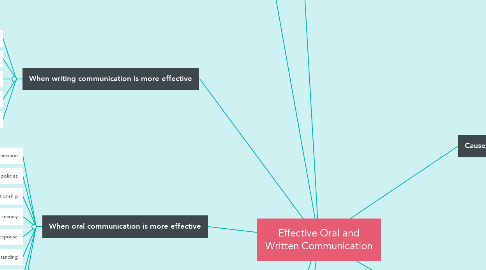Effective Oral and Written Communication
by Marco Leonardo Valencia Martínez

1. Five universal facts about communication that you should know
1.1. Communication is related to every human activity
1.2. Communication involves two or more parties
1.3. Communication may be one-way or two-way process
1.4. Communication in organization flows in various patterns
1.5. Communication is media or channel based
2. Principles of making effective communication in organization
2.1. Establish a warm atmosphere
2.2. Actively engage people’s interest
2.3. Be believable
2.4. Remember that your knowledge is limited
2.5. Use gestures well
2.6. Speak with your own voice
3. When oral communication is more effective
3.1. Instant communication
3.2. Detailed explanation of policies
3.3. Developing direct relationship
3.4. Maintaining secrecy
3.5. Instant response
3.6. Reaching to mutual understanding
3.7. Illiterate receivers
3.8. Avoiding bureaucratic complexities
4. Written communication
4.1. Oldest known form of communication
4.2. Concrete form of documentary evidence
4.3. Include letters, memos, research papers, reports, etc.
4.4. Easily distributed to many people
5. When writing communication is more effective
5.1. Conveying complex information
5.2. Need for permanent record
5.3. Communicating with large audience
5.4. Less need for interaction with audience
5.5. Maintaining uniformity of application
6. Tips to improve written communication
6.1. Use short and familiar words
6.2. Use short sentences and paragraphs
6.3. Use technical words with caution
6.4. Avoid unnecessary words
6.5. Give examples and charts
7. Oral communication
7.1. Transfer of information by means of verbal and visual aid
7.2. Carried out with the help of non-verbal communication
7.3. Quick and direct method of communication
7.4. Two-way communication can be enabled
8. Causes of failure of oral communication
8.1. Absence of planning
8.2. Over confidence
8.3. Over busyness
8.4. Quick transmission
8.5. Poor and defective presentation
8.6. Inattention
8.7. Status difference
8.8. Linguistic barrier
8.9. Disregard to receiver
8.10. Difference in personality
8.11. Receiver’s interpretation
8.12. Presence of emotion
8.13. Lack of evaluation


